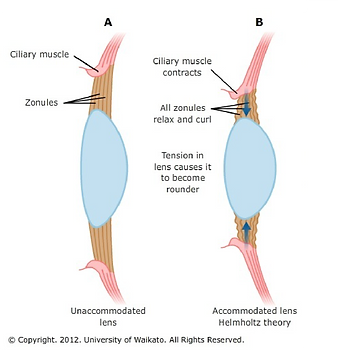Bates's Theories of Vision
In the realm of ophthalmology, there are very few people historically that have gone against the orthodox theories; bates happens to be one of them. Bates had unique theories of vision; theories that were celebrated by some and deemed nonsense by others. His perspective of how vision works, the different parts of vision and etc., nevertheless helped to make him famous.
More Coming Soon...
Fundamentals of Vision
Vision fundamentally works by causing an image to be focused on the retina: an area of light-sensitive cells at the back of the eye. These cells convert light to nerve impulses that are transmitted to the brain. All the other major parts of the eye all directly or indirectly work to make this happen.
Before getting to the retina, however, light has to be refracted or bent to be a properly focused image. There are two main refractive elements of the eye that aid in this. When we see an image, light first enters the eyes through the cornea: the first refractive element where 65-75% of the refraction occurs. The cornea is static, and it does not change its refractive power. The refraction of light through the cornea is not consciously controlled.
Theories of accommodation
The eyes, however, allow us to consciously change their overall refractive power. This happens because of the second refractive element. (Change in refractive power is required when we focus from a nearby vs faraway object) According to Helmholtz’s theory of accommodation (the act of focusing from far to near), the other refractive element is the ocular lens; it is positioned directly behind the cornea. Stretching and compressing the lens changes its refractive power as needed to be able to focus images.
Helmholtz’s theory was accepted by orthodox ophthalmology during Bates’s life and is still accepted today. Bates had an alternative theory. He believed that eye length is the mechanism that allows us to focus between images. The extraocular muscles of the eye (muscles that surround the eyeball) are the second refractive element. They stretch and compress the eyeball to change the eye’s length. This would move the retina forwards and backward as needed, and the retina would be positioned wherever the light is focused by the cornea and lens. These muscles allow us to change our refractive power in place of the lens. The lens is not used to focus at all!
Bates published experimentation and clinical studies that supported his theory of accommodation. He claimed that experiments on the extraocular muscles of fish, rabbits, cats, dogs and etc, showed that accommodation does not depend on the lens; It only depends on the extraocular muscles. These experiments were published in: “Bulletin of the New York Zoological Society” November 1914; and the “New York Medical Journal” for May 8, 1915, and May 18, 1918.
Bates manipulated the extraocular muscles by electrical stimulation and found he could produce accommodation in these animals at will. If these muscles were cut, however, then he couldn’t get the eye to accommodate. This proved the extraocular muscles were needed.
Dr. Bates even attempted to replicate Helmholtz’s experiments, which he found very difficult to do. He studied images reflected off the cornea, lens, iris, and sclera as previously done; In the end, however, arrived a different conclusion: accommodation was due to the lengthening of the eye, not the lens. The lens did not change shape as previously concluded. Helmholtz’s had a defective technique, and his experiment was misjudged.
Additional support for his theory was around atropine. According to Bates, In 1 out of 10 cases, atropine (a compound used to relax and paralyze muscles of the eye) when injected into the ciliary muscle (the muscle that controls the lens) was not able to stop accommodation as intended. The eye has been able to focus even after atropine delivery. Dr. Bates’s deduced through his experiments that accommodation can only be completely stopped if atropine is given to the extraocular muscles. So the second refractive element must be those muscles
Bates observed that patients who have had their lens removed during cataract surgery have been able to focus normally as before. If the lens was a factor in accommodation, this would not be possible. Similarly, bates also reached this conclusion because presbyopia was naturally reversible. Presbyopia is common in old age; it is when the lens hardens and near focus becomes difficult. The lens loses its elasticity and is not able to stretch as well, usually leading to the need for reading glasses. Bates claimed to cure his own presbyopia. If the lens needed for focusing, then curing presbyopia would be impossible.
Eye-Mind connection
Bates theories of vision were not limited to physiology. Holistically, he believed vision was governed by two parts: physiology and mental. The physiological aspect is contained within the eye: the muscles, tissues, structures and etc… The mental part, however, was in the majority: 90%. The eye is just a collection of tissues that light falls on. The mind, however, makes the physical adjustments necessary and registers the image.
One of Bates’s concepts of vision was that there is a strong eye-mind connection. Both the eyes and the mind are engaged or used in order to “see” properly. The mind and emotion have major effects on vision. Bates believed when speaking on worsened or bettered vision, the mind can’t be ignored. For example, mental strain would often result in eye strain: dry eyes, red eyes, poor vision. On the other hand, a relaxed mind such as during a walk through the park results in the better-than-usual vision. Your vision is better when you do things you like versus tasks that seem like chores. Bates incorporated this belief of his in the bates method.
Another concept was that vision is not static and discrete. Rather according to the bates-point-of-view, it’s variable and continuous; your eyesight continuously changes. Vision changes when you are happy/sad or when you are stressed/relaxed. Bates said you can notice your refractive error vary with emotions.

